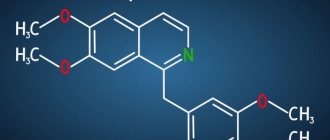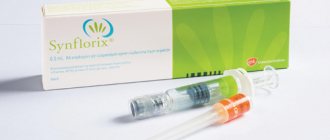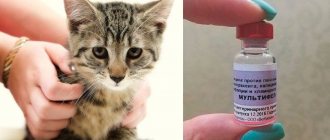Release form, packaging and composition of the drug Clinical-pharmacological group Pharmaco-therapeutic group Pharmacological action Indications for use Method of administration and doses Side effects Contraindications for use Use in children Special instructions Drug interactions
Registration Certificate Holder:
NOVARTIS VACCINES AND DIAGNOSTICS, Srl (Italy)
ATX Code:
J07BB02
Active substance:
inactivated influenza vaccine (surface antigen)
Dosage form:
Agrippal S1
| The drug is available with a prescription | Agrippal S1 | Susp. intramuscular and subcutaneous injection 0.5 ml/1 dose: syringes with needles 1 pc. reg. No.: P N012054/01 dated 03/23/07 - Cancellation of State. registration Date of re-registration: 05/19/15 |
Release form, packaging and composition of the drug Agrippal S1
Suspension for intramuscular and subcutaneous administration
colorless, transparent.
| 1 dose ( 0.5 ml) | |
| purified surface antigens of influenza viruses types A and B*, containing the following strains: | |
| A (H1N1) | 15 mcgHA** |
| A (H3N2) | 15 mcgHA** |
| B | 15 mcgHA** |
Excipients
: sodium chloride, potassium chloride, potassium phosphate dihydrate, sodium phosphate dihydrate, magnesium chloride, calcium chloride, water d/i; does not contain preservatives.
0.5 ml - glass syringes with needles (1) - blisters (1) - cardboard packs.
* grown on chicken embryo culture inactivated by formaldehyde. ** hemagglutinin.
The vaccine complies with WHO recommendations for the current epidemic season. The antigenic composition of the vaccine is updated annually according to WHO recommendations.
Agrippal S1 (Agrippal)
Release form, composition and packaging
Suspension for intramuscular and subcutaneous administration in the form of a colorless, transparent liquid.
0.5 ml (1 dose) purified surface antigens of influenza viruses types A and B grown on chicken embryo culture inactivated by formaldehyde; represented by the following strains.
Excipients: sodium chloride, potassium chloride, potassium phosphate dihydrate, sodium phosphate dihydrate, magnesium chloride, calcium chloride, water for injection.
- hemagglutinin.
- The antigenic composition of the vaccine complies with WHO recommendations for the current epidemic season.
Clinical and pharmacological group: Vaccine for the prevention of influenza.
pharmachologic effect
Vaccine for the prevention of influenza. Protective levels of antibodies usually develop 2-3 weeks after vaccination, and the duration of immunity ranges from 6 to 12 months.
Indications
The Agrippal S1 vaccine is intended for the prevention of influenza from 6 months of age. Immunization is especially indicated for adults and children from the following risk groups:
- adults and children with concomitant diseases of the cardiovascular system, chronic respiratory diseases, chronic kidney diseases, chronic anemia, congenital and acquired immunodeficiencies, diabetes and other chronic metabolic diseases;
- persons over 60 years of age;
- persons with a high professional risk of infection and persons who, due to their professional activities, can become a source of infection. During periods of epidemics or pandemics, it is recommended to vaccinate all groups of the population.
Dosage regimen
The vaccine cannot be administered intravenously! The vaccine is administered intramuscularly, mainly into the deltoid muscle, or deep subcutaneously. In young children, the vaccine can be injected into the anterior lateral thigh. Before use, the contents of the syringe should be warmed to room temperature.
Shake thoroughly.
Children from 6 months to 35 months are prescribed 0.25 ml (half the dose).
For children who have not previously been vaccinated , double vaccination is recommended with an interval of 4 weeks. Children over 35 months , adolescents and adults are prescribed 0.5 ml.
When using a syringe containing 0.5 ml of vaccine to immunize children for whom half the dose (0.25 ml) is indicated, it is necessary to remove half of its contents by pressing the plunger to a special mark. The remaining amount of vaccine should then be administered.
Vaccination should be carried out, if possible, before the start of the flu season (in the autumn-winter period). However, depending on the epidemiological situation, it may be necessary to conduct it at other times of the year. Vaccination is recommended annually.
Side effect
Regular (>1/100, <1/10)
Local reactions: redness, bruising, induration, pain and swelling at the injection site.
General reactions: fever, malaise, chills, weakness, headache, sweating, myalgia, arthralgia. These phenomena usually go away on their own within 1-2 days.
Unusual (>1/1000, <1/100)
Dermatological reactions: general skin reactions, including itching, urticaria, nonspecific skin irritation. Rare (>1/10,000, <1/1000)
From the nervous system: neuralgia, paresthesia (burning sensation, numbness), convulsions.
From the hematopoietic system: short-term thrombocytopenia. Allergic reactions have been noted, in rare cases leading to the development of shock, symptoms of serious allergic reactions, including anaphylactic reactions: sudden sharp drop in blood pressure, increased or decreased heart rate, unusual weakness or malaise, anxiety, nervousness, loss of consciousness, difficulty breathing and swallowing, itching (especially on the feet and palms), hives with or without swelling most often localized to the extremities, genital area, face (especially around the eyes and lips), rash (especially around the ears), nausea, vomiting, cramping stomach pain, diarrhea .
Very rare (1/10,000)
Vasculitis with impaired renal function is possible.
From the nervous system: encephalomyelitis, neuritis, Guillain-Barre syndrome (acute polyneuropathy with a predominant deterioration of motor function, paralysis). All of these side effects are usually short-term and transient in nature. If they appear, you should consult a doctor. The patient should be informed of the need to report to the doctor any unusual adverse reactions not described in these instructions.
Contraindications
- hypersensitivity to chicken egg white;
- a history of allergic reactions to other components included in the vaccine, or to a previous vaccination with this drug.
Vaccination of persons who have had an acute infectious disease is carried out 1 month after recovery. In mild forms of the disease, vaccination can be carried out after the temperature has normalized.
Pregnancy and lactation
The existing experience of using the vaccine in pregnant women has shown that Agrippal S1 does not have a teratogenic or toxic effect on the body. This vaccine can be used from the second trimester of pregnancy. For pregnant women who, for medical reasons, are at risk of developing complications after an influenza infection, vaccination is recommended at any stage of pregnancy. Vaccination can be carried out during the entire period of lactation (breastfeeding).
special instructions
As with other injectable vaccines, supplies should always be available to treat anaphylactic reactions. The vaccine may contain residual amounts of formaldehyde, cetyltrimethylammonium bromide and polysorbate 80, which are used in the vaccine production process (may cause hypersensitivity reactions). Overdose Data on overdose of the Agrippal S1 vaccine are not provided.
Drug interactions
The use of the Agrippal S1 vaccine within the framework of the preventive vaccination calendar for epidemic indications and inactivated vaccines of the national preventive vaccination calendar is possible simultaneously, provided that it is administered with different syringes and in different parts of the body or with an interval of one month. In this case, the possibility of increasing the intensity of adverse reactions should be taken into account. In patients receiving immunosuppressive therapy, as well as in people with congenital and acquired immunodeficiencies, vaccination may be less effective. False-positive ELISA results for antibodies against HIV infection (HIV1), hepatitis C virus, and especially against T-cell antibodies have been reported after influenza vaccination. human lymphotropic virus (HTLV1).
To exclude a false positive result, it is necessary to conduct a study using the Western Blot method. Short-term false-positive results may be associated with the appearance of IgM immunoglobulin in response to vaccination. The Agrippal S1 vaccine should not be mixed with other medicinal substances.
Storage conditions and periods
The vaccine should be stored in a place protected from light, out of reach of children, at a temperature of 2° to 8°C; do not freeze. The vaccine should be transported in accordance with SP 3.3.2.1248-03 by all types of covered transport at a temperature of 2° to 8°C; do not freeze.
Shelf life: 12 months. Do not use the vaccine after the expiration date stated on the label and outer packaging.
pharmachologic effect
Vaccine for the prevention of influenza. It is a trivalent subunit inactivated influenza vaccine consisting of surface antigens (hemagglutinin /HA/, neuraminidase /NA/), cultured on chicken embryos of healthy chickens, influenza viruses type A and B.
The antigenic composition of the influenza vaccine is updated annually according to WHO recommendations.
The vaccine forms the development of specific immunity to influenza viruses type A and B, which usually occurs 14 days after immunization and lasts up to 1 year.
Indications for use
Prevention of influenza in adults and children over 6 months.
Vaccination is recommended for all individuals and, above all, for the following categories of the population who are at increased risk if influenza is combined with existing diseases: patients over 65 years of age, regardless of their health status; patients with respiratory diseases, including bronchial asthma; patients with cardiovascular diseases of any etiology; patients with chronic renal failure; patients with chronic metabolic disorders, including diabetes mellitus; patients with immunodeficiency diseases and patients receiving immunosuppressants, cytostatics, radiation therapy or corticosteroids in high doses; children and adolescents aged 6 months to 18 years who have been receiving medications containing acetylsalicylic acid for a long time and, therefore, are at increased risk of developing Reye's syndrome due to influenza infection.
Do I need to get vaccinated against the flu?
Influenza is a respiratory disease of viral etiology that occurs in an acute form.
It is part of the ARVI group and regularly spreads in the form of epidemics. Most often, its clinical manifestations go away on their own within seven days - however, there are often cases when the virus can cause complications and even death. According to statistics, more than half a million people die from it every year and about five million become seriously ill.
There are no specific drugs against influenza; even antibiotics and antivirals are not always effective. The best results come from preventive measures in the form of vaccinations. It has been used for more than sixty years and is carried out every year, since after this time the immune system weakens.
Vaccination using Agrippal S1 and other drugs can reduce morbidity rates by two to three times. Thanks to it, the mortality rate of sick people is significantly reduced (especially those who are at risk: children and elderly patients). Researchers note high effectiveness in children aged six months to seven years.
Directions for use and doses
The method of administration and dosage regimen of a particular drug depend on its release form and other factors. The optimal dosage regimen is determined by the doctor. The compliance of the dosage form of a particular drug with the indications for use and dosage regimen should be strictly observed.
Injected intramuscularly or deeply subcutaneously. The dosage regimen is individual, depending on the indications, the patient’s age and the clinical situation. The injection should be carried out with caution to avoid the drug entering the intravascular bed. It is strictly forbidden to administer the drug intravenously!
Population groups recommended for annual vaccination
The World Health Organization recommends influenza vaccination for the following populations:
- pregnant women;
- patients over 65 years of age;
- children from six months to five years;
- patients suffering from chronic lung and heart diseases;
- healthcare industry employees.
It is especially important for those who are at high risk of complications, as well as the people they live with or those who care for them.
Side effect
From the nervous system:
headache, neuralgia, paresthesia, convulsions, encephalomyelitis, neuritis, Guillain-Barré syndrome.
Dermatological reactions:
increased sweating, generalized skin reactions, including itching, urticaria or nonspecific rash.
From the musculoskeletal system:
myalgia, arthralgia.
Local reactions:
redness, swelling, pain, induration*, ecchymosis.
Other:
increased body temperature, malaise, chills, fatigue.
From the hematopoietic system:
transient thrombocytopenia, transient lymphadenopathy.
Allergic reactions:
manifestations of allergic reactions; in some cases - angioedema, anaphylactic shock.
From the cardiovascular system:
vasculitis in very rare cases accompanied by transient renal dysfunction.
Agrippal S1
Vaccine for the prevention of influenza.
Manufacturer: Novartis Vaccines and Diagnostics S.r.l., Italy.
Compound. Purified surface antigens of influenza viruses types A and B, containing the following strains: A (H1N1), A (H3N2), B. Excipients: sodium chloride, potassium chloride, potassium phosphate dihydrate, sodium phosphate dihydrate, magnesium chloride, calcium chloride, d/i water; does not contain preservatives.
Contraindications: hypersensitivity to chicken egg white; a history of allergic reactions to other components included in the vaccine, or to a previous vaccination with this drug. Vaccination of persons who have had an acute infectious disease is carried out 1 month after recovery. In mild forms of the disease, vaccination can be carried out after the temperature has normalized.
Adverse reactions. Common: redness, bruising, induration, tenderness, and swelling at the injection site; fever, malaise, chills, weakness, headache, sweating, myalgia, arthralgia. Unusual - general skin reactions, including itching, urticaria, nonspecific skin irritation. Rare - neuralgia, paresthesia (burning sensation, numbness), convulsions; short-term thrombocytopenia. Allergic reactions have been noted, in rare cases leading to the development of shock, symptoms of serious allergic reactions, including anaphylactic reactions. Very rare - possible vasculitis with impaired renal function; encephalomyelitis, neuritis, Guillain-Barré syndrome.
For what diseases is the Agrippal S1 vaccine used?
- Flu - 6 months, 18.5 years
What are the alternatives to the Agrippal S1 vaccine:
- Begrivak
- Vaxigrip
- Flu vaccine inactivated eluate-centrifuge liquid
- Grippol
- Grippol plus
- Influvac
- Fluarix
We recommend reading:
again about vaccinations Agrippal is also registered, but as far as I know, it is not currently available in Russia.
You can get vaccinated now, since in your case you need 2 vaccinations at intervals of a month... Flu vaccination - is it really necessary? Spelled with one “p” And Influvac, and Fluarix, and Agrippal, and Grippol are good, but Vaxigrip is the best in all respects, no matter how you look at it.
Spelled with one “p” And Influvac, and Fluarix, and Agrippal, and Grippol are good, but Vaxigrip is the best in all respects, no matter how you look at it.
Other people's children do not evoke emotions 04/16/2017 01:32:20, A1S.
And again the children of the Primorsky Territory Olesya B. Profile number: 93n1k-1s00 Region: Primorsky Territory The girl was born in March 2007 Eye color: brown Hair color: dark blond Character: contact Possible forms of the device...
two important questions. Vaxigrip-thermonuclear vaccine, next time do something easier: Fluarix, Agrippal, Influvac. This is my Ph.D. on vaccination he said about vaxigrip...
Poll: Should I get a flu shot? Receive answers by email. show links to images as pictures. I'm doing Agrippal for the 2nd year (I think).
Nadezhda… https://www.usynovite.ru/files
Who has learned to live with this? PS 1) Near-psychiatric topics are “thin ice”, if my post offended you, write, I will delete it. 2) Is the child neurologically healthy?
The Children in Need project is looking for a family. FBD: Snezhana Shch. No. ceond-1s3op Moscow region No brothers and sisters Possible forms of placement: adoption, guardianship Girl born in March 2010 Eyes brown Hair…
Reply to Anya Levchenko By the way, your list is not complete - add several vaccines produced by Berna (Switzerland), for example Epaxal and Agrippal produced by Chiron Behring (Italy-Germany).
To the main page of the preventive vaccination calendar
special instructions
When conducting vaccination, it is necessary to have all means for emergency treatment of anaphylactic shock (including epinephrine/adrenaline/, GCS). In patients with endogenous or exogenous immunosuppression, the immune response may be insufficient. 1 dose of the vaccine should not contain more than 1 mcg of ovalbumin. After vaccination, it is possible to obtain false-positive results from serological tests based on the ELISA method (enzyme-linked immunosorbent assay) when determining antibodies against HIV (HIV1), hepatitis C, and human T-cell lymphotropic virus (HTLV1). Laboratory diagnostics using the Western Blot method eliminates false-positive results from tests based on the ELISA method. Transient false-positive results may be due to IgM production after vaccination.




